Trains in New Zealand don’t enjoy a large network like in, for example, Europe or Queensland (where passenger trains and sugar cane trains respectively are very common), but you will encounter different types of crossings, and there are many signs you might see upon approach to a level crossing. A railway level crossing is where your vehicle must directly drive over train tracks and where there is a danger of you coming into contact with a train.
Trains cannot stop quickly and they can’t deviate from their course. Their wheels provide very low friction on the track, especially if it is wet. A laden freight train travelling at 80kph can take over a kilometre to stop.
Where is the crossing?
Signs indicating a crossing on a side road
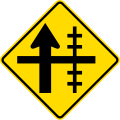 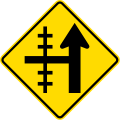 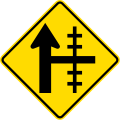 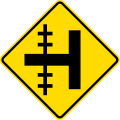 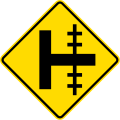 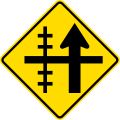 | These signs let you know that there will be a level crossing very soon after you turn in the direction indicated on the sign. You should watch out for queued traffic. If you are turning right only turn into the road if you are sure that you can complete your manoeuvre and aren’t left stranded and unable to clear the right lane. |
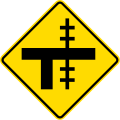 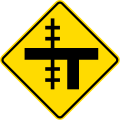 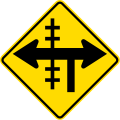 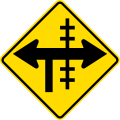 | You will see these signs if you are approaching a t-intersection and there is a level crossing either to the right or left (as indicated). Again, make sure that you can complete your manoeuvre if you are turning right so that you are not stranded half way across the road. |
Signs indicating the direction of a crossing
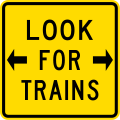 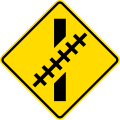 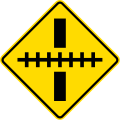 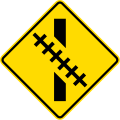 | These signs show you which way the trains will be approaching from. If the angle is oblique you will need to pay extra attention to look in your blind spots for approaching trains if there are no lights, barrier arms or sirens. |
Types of railway crossing
In New Zealand we have several types of railway crossing.
Level crossings
A railway level crossing is where the tracks cross over the road at the same level, i.e. road users must drive across the tracks. These can be uncontrolled (give way or stop sign) or controlled (lights, sirens and/or barrier arms).
There are around 3000 railway level crossings in New Zealand, some on public land and some on private land. Around half of them are uncontrolled.
Tunnels and cuttings
Trains can pass under roads using tunnels and cuttings (where the railway is dug into a channel and the road passes of the top of it over a bridge).
Bridges
Trains can pass over roads on bridges, such as this one over The Strand in Auckland.
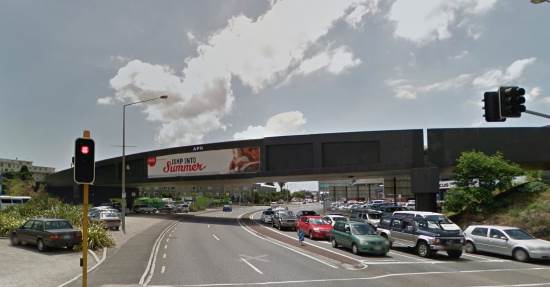
Railway bridges only need signage if their height is restricted. Bridges over a railway only need signage if there is some kind of restriction for certain types of vehicles, for example, a weight or width restriction.
Railway level crossings, however, need much more signage to warn road users that they are approaching an obstacle for which they might have to stop and give way to a train.
Warning signs
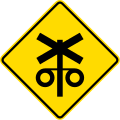 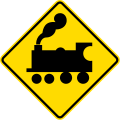 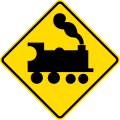  | As you approach the railway track you will see warning signs usually around 200m before the track that indicate a crossing is ahead. These are usually a yellow sign with a train pointing either left or right and/or a crossbuck (two crossed planks of metal or their graphical equivalent that say Railway Crossing). When you see these signs you should slow down and be ready to stop. As you approach the railway crossing you should scan up and down the line for approaching trains, even if the barrier arms, lights or bells (if present) aren’t working). Trains can travel at high speed, so be careful. Cross only if you can make it all the way across the crossing without other vehicles blocking your path, and if you are sure there are no trains coming. |
Barrier arms and/or lights and sirens
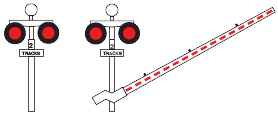
The safest crossings are those controlled by barriers arms. There will also be flashing lights, and often bells or another type of audible warning (although, these often do not operate in the middle of the night if in an urban area to avoid disturbing residents).
The sign under the lights will show you how many lines you have to cross, e.g. 2 tracks.
If the lights are flashing, the bells are ringing and/or the barrier arm has started to lower, then you must stop. If you are already crossing the tracks as the barrier arm starts to lower, complete your crossing – do not stop on the tracks. You must stay where you are until the barrier arm has lifted and the lights and bells have stopped. Check each way up the track before you proceed just in case there is still a train coming.
Do not zig-zag around barrier arms that are down.
If a train passes and the barrier arms stay down, the lights keep flashing and the bells continue to sound there may be another train coming.
Uncontrolled level crossings
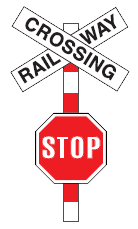
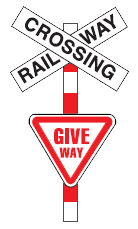
Uncontrolled crossings will have either a stop sign or give way sign which you must obey. As you approach the crossing make sure you can see in both directions along the railway line. If there’s a stop sign then there will usually be one or two yellow lines painted on the road before the crossing that show you where is the safest to stop. If there are no trains coming then you can cross the railway line.
If you see a train coming, don’t try to race it across the line. Trains can be moving at 80kph or more and will bear down on your vehicle very quickly.
What should you do if you get stuck on a railway line?
It is very rare for a vehicle to become stuck on a railway line. There are specific dangers for long, low vehicles where the lines are raised in relation to the road in that the tracks might beach the vehicle.
If you stall the vehicle on the tracks, or you break down and it won’t start, you have two options:
If it’s a manual car, put it in first gear and use the starter motor to move the car. The starter motor will have enough power to push the car forward in small jumps until you are clear of the track. You cannot use this technique in an automatic vehicle.
If the starter motor is not working, the battery has run out or your vehicle is automatic, put the vehicle in neutral, get everyone out of the vehicle and see if you can push it off the tracks. You will know within 10 seconds whether you can move it. Bear in mind that with no one in the vehicle you will still need someone to steer it through the drivers door. If the vehicle won’t move get everyone way from the vehicle, preferably at least 50m away. Use a railway telephone (if available) to tell the signal operator, or call traffic police on *555 to get further instructions.
Always be aware of what is coming up the tracks and if the bells sound or lights start flashing get well clear of the vehicle preferably in a direction slightly towards the train as debris will be scattered in the opposite direction.
Motorbikes and cyclists should take extra care as the metal rails are slippery, plus there is a risk of narrow wheels more easily getting caught in the tracks, or the bumps unbalancing the rider.
This is especially important if you are driving a long vehicle. As you can see in the video below, if you get caught out on the crossing, the train cannot stop quickly.
Therefore, as you approach a railway level crossing, check how many lines you will need to cross, and that there is enough room for you to pass over the crossing and leave at least 5 metres behind you.
The following table is a historical time series of crashes and casualties for level crossing collisions (Crash Analysis System)
| Year | Crashes | Casualties | |||
| Total | Fatal | Deaths | Serious | Minor | |
| 2000 | 14 | 3 | 4 | 7 | 8 |
| 2001 | 16 | 4 | 4 | 0 | 18 |
| 2002 | 14 | 6 | 6 | 4 | 7 |
| 2003 | 16 | 3 | 3 | 10 | 7 |
| 2004 | 21 | 7 | 8 | 7 | 11 |
| 2005 | 21 | 4 | 4 | 8 | 14 |
| 2006 | 7 | 2 | 2 | 6 | 1 |
| 2007 | 15 | 3 | 5 | 6 | 13 |
| 2008 | 10 | 1 | 1 | 5 | 8 |
| 2009 | 12 | 3 | 4 | 8 | 6 |
| 2010 | 8 | 0 | 0 | 4 | 7 |
| 2011 | 10 | 2 | 2 | 5 | 8 |
| 2012 | 13 | 2 | 2 | 4 | 9 |
| 2013 | – | 2 | 2 | – | – |

